2014 下半年上海教师资格高中英语学科知识与教学能力真
题及答案
一、选择题(本大题共 30 小题,每小题 2 分,共 60 分)
在每小题列出的四个备选选项中选择一个最佳答案,请用 2B 铅笔把答题卡上对应题目的答
案字母按要求涂黑。错选、多选或未选均无分。
1.which of the following is the proper pronunciation of “have to “ as a result
of assimilation?
A./hef tu/
1.【答案】C。
D. /hæv tu/
C. /hæf tu/
B. /hev tu/
2.which of the following shows the proper rhythmical pattern of the sentence?
A.´Come to ´see us at our ´new a`partment
B.`Come to`see us at `our new `apartment
C.`Come to`see us `at our `new` apartment
D.`Come to `see us`at our`new a`parement
2.【答案】A。
3.He came to dinner and my mom fixed a roast, prime rib ,pie, yohurt, drinks, and
that kind of _,and it was really good.
A. meat
3.【答案】B。
C. staff
B. stuff
D. Dish
4.Unlike her _sister, Judith is a shy ,unsociable person who dislike to go to
parties or to make new friends.
A. charming
B. friendly
4.【答案】D。
D. Gregarious
C. gracious
5.He pledged support for “_care”,where youngsters were looked after be close
relatives like aunts or uncles, but not parents.
A. family
5.【答案】B。
D. Relative
C. sibling
B. kinship
6.I will never know all that was in his head at the time , _.
A. nor will anyone else
C. nor won´t anyone else
6.【答案】A。
B. nor anyone else will
D. nor anyone else won´t
7. She doesn´t want to work right now because she thinks that if she _a job she
probably wouldn´t be able to visit her friends very often .
A. has to get
7.【答案】B。
D. could have got
B. were to get
C. had got
�
B. One hundred and six point sixteen
D. One hundred and six points sixteen
8. What is the correct way to read the decimal “106.16” in English?
A. One hundred and six point one six
C. One hundred and six points one six
8.【答案】A。
9. When any of the maxims under the Cooperative Principle is flouted on purpose,
might arise.
A. ambiguous structure
C. mutual understanding
9.【答案】D。
B. contradictory proposition
D. conversational implicature
10. Indian English is a _ variety of the English language.
A. social
10.【答案】B。
B. regional
C. historic
D. Situational
11. In teaching pronunciation, the teacher should tell the students that _ can be
used to convey more important messages.
A. rhyme
11.【答案】B。
C. devoicing
D. Rhythm
B. stress
12. When a teacher asks students to discuss how the writerˊs ideas are organized
in the text, he /she intends to develop studentsˊ skill of _ .
12.【答案】A。
13. Which of the following focus(es) on accuracy in teaching grammar?
A. simulation
C. role play
13.【答案】B。
B. substitution drills
D. Discussion
14. When a teacher says “Next, please pay attention to the time of arrival and
departure of the planes in the recording .” ,he/she intends to develop students'
skill of _ .
A. predicting
C. distinguishing sounds
14.【答案】D
B. getting the general picture
D. getting specific information
15. If a teacher asks students to list as many ways as they can to tell someone to
open the door and list the possible functions of a sentence in different contexts.
he/she is probably trying to highlight _ .
15.【答案】C。
16. The teacher would use _to help students communicate in teaching speaking.
A. substitution drills
C. listening and acting
16.【答案】B。
B. group discussion
D. reading aloud
�
17._ assessment is used to measure how the performance of a particular student or
group of students compares with that of another.
A. Criterion-referenced
C. Formative
17.【答案】C。
B. Norm-referenced
D. Summative
18. Which of the following teacher's instruction could serve the purpose of eliciting
ideas?
A. Shall we move on?
C. What can you see in this picture
18.【答案】C。
D. What does the world “quickly” mean?
B. Read after me, everyone
19. Which of the following is an example of teachers'indirect corrective feedback?
A. Say “went” instead of “go”
C. Choice A is not the right answer
19.【答案】D。
D. Who can help him with this sentence?
B. We never use “at” that way
20. Total Physical Response as a TEFL method is more often used for teaching _.
A. children
20.【答案】A。
C. ESP course
B. adults
D. GE course
请阅读 passage1,完成第 21~25 小题
Passage 1
Unless you spend much time sitting in a college classroom or browsing through
certain areas of the Internet, it's possible that you had not heard of trigger
warnings until a few weeks ago, when they made an appearance in the Times. The
newspaper explained that the term refers to preemptive alters, issued by a professor
or an class might be sufficiently graphic to spark symptoms of post-traumatic-stress
disorder.
The term seems to have originated in online feminist forums, where trigger
warnings have for some years been used to flag discussion of rape or other sexual
violence. The Times piece, which was skeptically titled “warnings are moving from
the online fringes to the classroom, and might be more broadly applied to highlight
in advance the distress or offense that a work of literature might cause.
“Huckleberry Finn” would come with a warning for those who have experienced racism;
The Merchant of Venice would have an anti-Semitism warning attached. The call from
students for trigger warnings was spreading on campuses such as Oberlin, where a
proposal was drafted that would advise professors to “be aware of racism, classism,
sexism, and other issues of privilege and oppression” in devising their syllabi;
and Rutgers, where a student argued in the campus newspaper that trigger warnings
would contribute to preserving the classroom as a “safe space” for students.
Online discussion of trigger warnings has sometimes been guardedly sympathetic,
sometimes critical. Jessica Valenti has noted on The Nation's website that potential
�
triggers for trauma are so manifold as to be beyond the possibility of cataloguing:
“There is no triggers for warning for living your life.” Some have suggested that
a professor's ability to teach would be compromised should it become commonplace
for “The Great Gatsby” to hear a trigger warning alerting readers to the disgusting
characters and incidents within its pages. Others have worried that trigger-warning
advocates, in seeking to protect the vulnerable, run the risk of disempowering them
instead, “Bending the world to accommodate our personal frailties does not help
us overcome them”, Jenny Jarvie wrote on The New Republic's online site.
Jarvie's piece, like many others on the subject, cited the University of California,
Santa Barbara, as a campus where champions of trigger warnings have made significant
progress. Earlier this year, students at U.C.S.B. agreed upon a resolution
recommending that such warnings be issued in instances where classroom materials
might touch upon “rape, sexual assault , abuse, self-injurious behavior, suicide,
and graphic violence”. The resolution was brought by a literature student who said
that, as a past victim of sexual violence, she had been shocked when a teacher showed
a movie in class which depicted rape, without giving advance notice of the content.
spare
The
a
post-traumatic-stress reaction.
The trigger-warning debate may, by comparison, seem hard to understand; but express
a large cultural preoccupation with achieving safety, and a fear of living in its
absence. The hope that safety might be found, as in a therapist's office, in a
classroom where literature is being taught is in direct contradiction to one purpose
of literature, which is to give expression through art to difficult and difficult
and uncomfortable ideas, and thereby to enlarge safe space, nor, probably, should
it be. But it's difficult to fault those who hope that it might be, when the outside
world constantly proves itself pervasively hostile, as well as, on occasion,
horrifically violent.
21. Which of the following groups of people are most in favor of “trigger warning”?
A. Students
21.【答案】A。
D. Professors
C. Feminists
experiencing
B. Reporters
the
possibility
others
student
hoped
to
of
22. Which of the following might be a possible change to be brought about by trigger
warning to literature teaching?
A. Teachers will abandon materials related to racism, sexism, violence, etc.
B. Teachers will ignore students's requests for a “safe space” in designing their
syllabi.
C. Teachers will give students advance notice of the content that is likely to
distress or offend them.
D. Teachers will allow students to express different and uncomfortable ideas to
enlarge their experience.
22.【答案】C。
23. What does the author mean by “compromised” in PARAGRAPH 3?
A. Questioned
C. Challenged
B. Improved
D. Weakened
�
23.【答案】D。
24. What does “them” in PARAGRAPH 3 refer to ?
A. Risks
C. Traumas
24..【答案】B。
B. Frailties
D. Possibilities
25. Which of the following can be the negative impact that trigger warning exerts
on literature teaching according to the writer?
A. It may highlight the purpose of literature teaching.
B. It may expose students to the dark side of the world.
C. It may deprive students of their intellectual growth.
D. It may cause students to experience a post-traumatic-stress disorder.
25..【答案】D。
请阅读 passage 2, 完成 26~30 小题。
Passage 2
The medical community owes economists a great deal. Amartya Sen won a Nobel Prize
for Economic Sciences in 1998. He has spent his entire career promulgating ideas
of justice and freedom, with health rarely out of his gaze. Joseph Stiglitz won a
Noble in 2001. In 1998, when he was chief economist at the (then) notoriously
regressive World Bank, he famously challenged the Washington Consensus. And Jeff
Sachs, a controversial figure to some critics, can fairly lay claim to the enormous
achievement of putting health at the center of the Millennium Development Goals.
His “Commission on Macroeconomics and Health” was a landmark report, providing
explicit evidence to explain why attacking disease was sbsolutely necessary if
poverty was to be eradicated. And I must offer my own personal gratitude to a very
special group of economists- Larry Summers, Dean Jamison, Kenneth Arrow, David Evans,
and Special Gupta. They were the economic team that drove the work of Global Health
2035.
But although we might be kind to economists, perhaps we should be tougher on the
discipline of economics textbook, and you will see the priority given to markets
and efficiency, price and utility, profit and competition. These words have chilling
effects on our quest for better health. They seem to marginalize those qualities
of our lives that we value most of all – not our self-interest, but out humanity;
not the costs and benefits of monetary exchange, but vision and ideals that guide
our decisions. It was these issues that were addressed at last week's Global Health
Lab, held at London School of Hygiene & Tropical Medicine.
Anne Mills, Vice-Director of the school, fervently argued the case in favor
of economists. It was they who contributed to understanding the idea of “best-buys”
in global health. It was economists who challenged user fees. And it was economists
who made the connection between health and economic growth, providing one of the
most compelling political arguments for taking health seriously. Some economists
might adore markets, but not health economists, she said. “Health care is
different.” For her kind of economist, a health system is a “social institution
�
that embodies that embodies the values of society”.
Although competition has a part to play in health, it should be used judiciously
as a mechanism to improve the quality of care. Chris Whitty, Chief Scientific Adviser
at the UK's Department for International Developments, expressed his contempt for
those who profess indifference to economics. Economic is about the efficient
allocation of scarce resources. Anyone who backed the inefficient allocation of
resources is “immoral”. He did criticize economists for their arrogance, though.
Economists seemed to believe their ideas should be accepted simply because of the
authority they held as economists. Economics, he said, is only one science among
many that policy markers have to take into account. But Clare Chandler. A medical
anthropologist, took a different view. She asked, what has neoliberal economics ever
done for global health? Her answer, in one word, was “inequality”, Neoliberal
economics frames the way we think and act. Her argument suggested that any economic
philosophy that put a premium on free trade, privatization, minimal government, and
reduced public spending on social and health sectors is a philosophy bereft of human
virtue. The discussion that followed, led by Martin Mckee, posed difficult questions.
Why do economists treat their theories like religions? Why are economists so silent
on their own failures ? Can economics ever be apolitical ? There were few
satisfactory answers to these questions.
26. Which of the following best describes the author's attitude toward economists?
A. Contempt
26.【答案】C。
B. Reservation
D. Endorsement
C. Detachment
27. Who holds a critical view on economists role in medical field according to the
passage?
A. Amartya Sen.
27.【答案】B。
D. Clare Chandler
C. Larry Summers
B. Jeff Sachs
28. Which of the following is closest in meaning to “discipline” in PARAGRPH 2?
A. Subject
28.【答案】A。
C. Punishment
B. Lesson
D. Regulation
B. Rhetorical questions
D. Direct quotation
29. Which of the following is NOT used in the author's presentation of his ideas?
A. Thesis statement
C. Specific examples
29.【答案】A。
30. What does the author intend to tell the reader?
A. There is still a long way to go for economists to genuinely contribute to global
health.
B. Economists' role in global health is, to a large extent, negative.
C. Economists increased the inequality of resource allocations in global health.
D. Economics is only one science among many that policy makers have to take into
account in providing health care programs.
�
30.【答案】A。
二、简答题(本大题 1 小题,20 分)
根据题目要求完成下列任务,用中文作答。
31.课堂提问的作用是什么?(8 分)封闭性问题与开放性问题各自有什么特点?(12 分)
31.【答案】(一)课堂提问的作用(8 分,每点 2 分)
(1)引起学生的注意,学生注意力不集中时,教师进行提问,往往可以唤回学生的注意力,
让学生重新回归课堂教学。
(2)巩固课堂教学。教师在课堂教学中以一组问题前后相连的形式,不断启发、追问、质
疑、概括、小结,那么学生就会比较全面、系统、牢固地掌握知识和技能。
(3)获取反馈信息。学生在答问时反映出的思维受阻、歧义、谬误、遗漏等一些现象,较
之凭借作业、测试等方式,能更及时、更清晰地展现在教师的面前,让教师能及时通过提示、
点拨、启发,或者反问、加问、追问,甚至调整策略,改换话题,另辟蹊径,达到合理引导
学生思维的目的。
(4)加强师生之间沟通与交流。教师提问,同学讨论,学生回答,是一种交流。课堂提问
不仅可以提高学生的表达能力,培养他们的团队精神,更可以促师生感情融洽,从而更好地
推动教学。
(二)封闭性问题和开放性问题的特点(12 分)
A.封闭性问题特点:(6 分,每点 2 分)
(1)从问题答案的角度:封闭性问题有固定答案,且答案唯一。
(2)从锻炼学生能力的角度:强化巩固课堂所学,记忆必须死记硬背的知识。
(3)从课堂教学的角度:提高课堂提问的有效性方面发挥了重要作用。
B.开放性问题特点:(6 分,每点 2 分)
(1)从问题的答案来看:答案不是唯一的,是多种多样的。
(2)从锻炼学生能力的角度:培养学生的发散思维,促进学生创新能力的提高。
(3)从课堂教学的角度:创设一个比较宽松、自由的问题情境,学生充分发挥自己的聪明
才智,通过不同角度的探索,自己去获取新知识,巩固原有的知识。
三、教学情境分析题(本大题 1 小题,30 分)
根据题目要求完成下列任务,用中文作答。
32.下面是某教授的课堂教学片断:
T:…Now, let's make our own wishes with “if only”. But please don't forget
to give a description, even though it's very brief, of situation, the context, where
you make the wish with one or two sentences… how about Liz?
Liz: Now it's So' clock, and there is a traffic jam on the express way. The
hotel will cancel our room at 6 0' clock if we do nor get to the hotel. Then, I'
ll say: oh, I wish if only I didn't go on the journey.
T: Listen, Liz. You see, once you use “I wish”, you don't need to use “if
only”, Just use either one.
Liz: Yes.
T; So will you try again? Just the wish.
�
Liz; If only I didn't go on the journey.
T; To make it better, you can say “if only hadn't gone on this journey”, because
you are already on the way. Go on, please.
请根据所给材料,分析该教师的教学目的和教学过程,评价其教学行为和反馈方式。
32.【答案】(一)分析教学目的和教学过程
(1)教学目的:(9 分)
知识目标:学生掌握由“If only”引导的虚拟语气的用法。
技能目标:提高学生的英语造句能力,、语法运用以及英语表达能力。
情感目标:学生可以正确认识自己的错误并且改正错误,养成良好的意志品质。
(2)教学过程:(5 分)
该教学情境属于语法教学中的环节。教师采用让学生创设语境进行造句的方法对所学的 If
only 引导的虚拟语气的用法进行巩固。教学过程中师生对话,既学习了语法又锻炼了口语
表达能力。
(二)评价教学行为和反馈方式(16 分)
优:(1)及时评价,帮助学生纠正语法错误。做到语法训练的准确性。(2)语法巩固练习设
置要求学生结合具体语境造句,可以锻炼学生在自己所创设的语境中应用英语,锻炼了综合
语言运用能力。(3)教学素材的使用贴近学生生活,如:make our own wishes 就可以让学
生有话可说,体现了英语教学的实践性,真正体现了素质教学的理念。(4)该教学片断属于
语法教学中的巩固环节,因此,体现了语言教学的渐进性、持续性。
缺:(1)语法巩固练习形式略显单一枯燥,该教师仅采用了让学生造句的练习方法。(2)反
馈过程缺少对学生的鼓励,会打击学生学习的积极性。学生回答问题之后,没有鼓励学生,
而是直接“ Listen, Liz. You see, once you use …” (3)反馈的方式过于直接,可以采
用引导的方式,让学生自己发现自己的语法错误并进行改正,达到印象深刻的目的。该教师
在教学过程中总是直接指出学生的错误。(4)教师没有充分预料到学生的出错点,做到提前
纠错。如在让学生造句之前,应该区别 if only 和 wish 在虚拟语气句子中的用法。这样
在学生造句过程中就不会出现 Liz 的问题了。
四、教学设计题(本大题 1 小题,40 分)
根据提供的信息和语言素材设计教学方案,用英文作答。
33.设计任务:请阅读下面学生信息和语言素材,设计一节语言读写课教学方案。教案没有
固定格式,但须包含下列要点:
-teaching objectives
-teaching contents
-key and difficult points
-major steps and time allocation
-activities and justifications
教学时间;45 分钟
学生概况:某城镇普通中学高中一年级第二学期学生,班级人数 40 人,多数学生已经达到
《普通高中英语课程标准(试验)》五级水平,学生课堂参与积极性一般。
Town Twinning
How are Oxford in the UK and Grenoble in France similar? Well, they are both
medium-sized towns of between 100,000 and 200,000 inhabitants. They both have
universities and industries. Tourism is important to both of them, and they are both
�
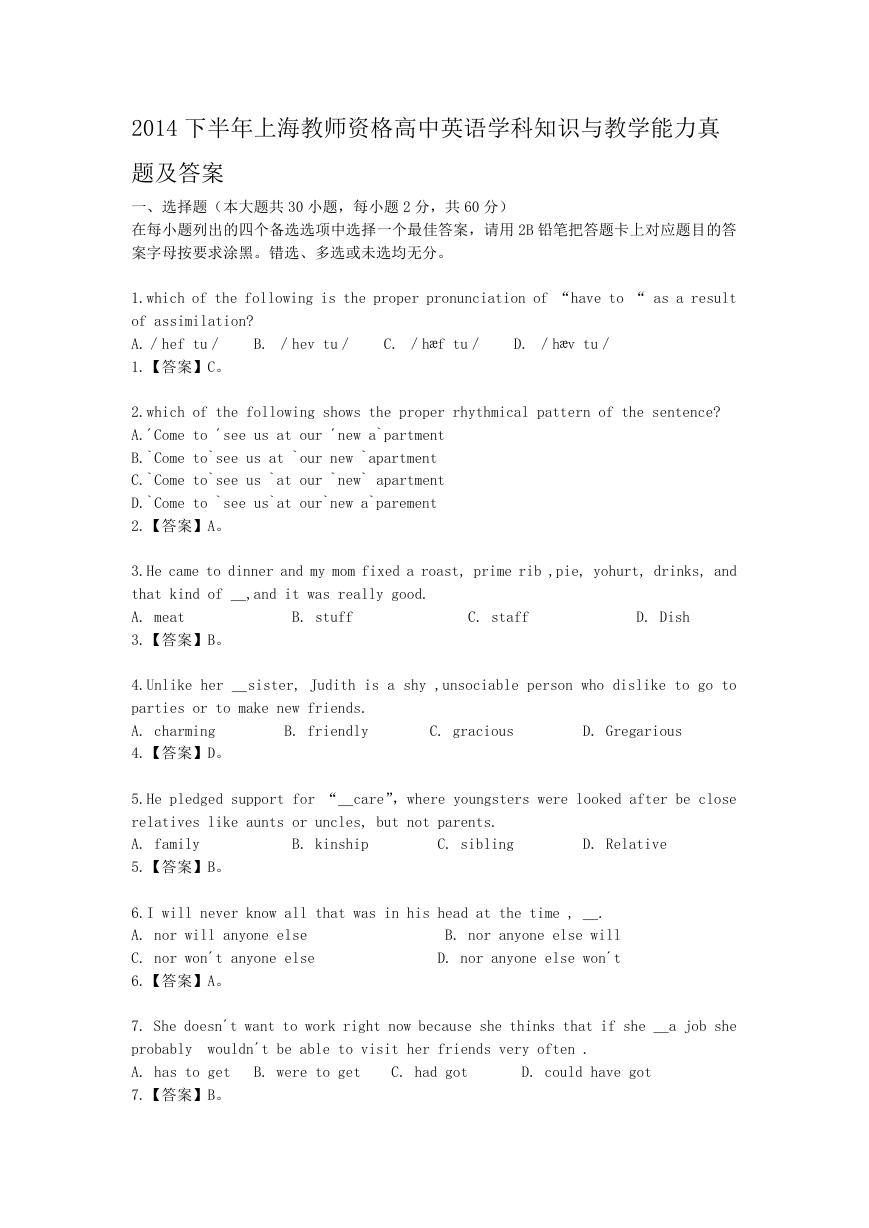
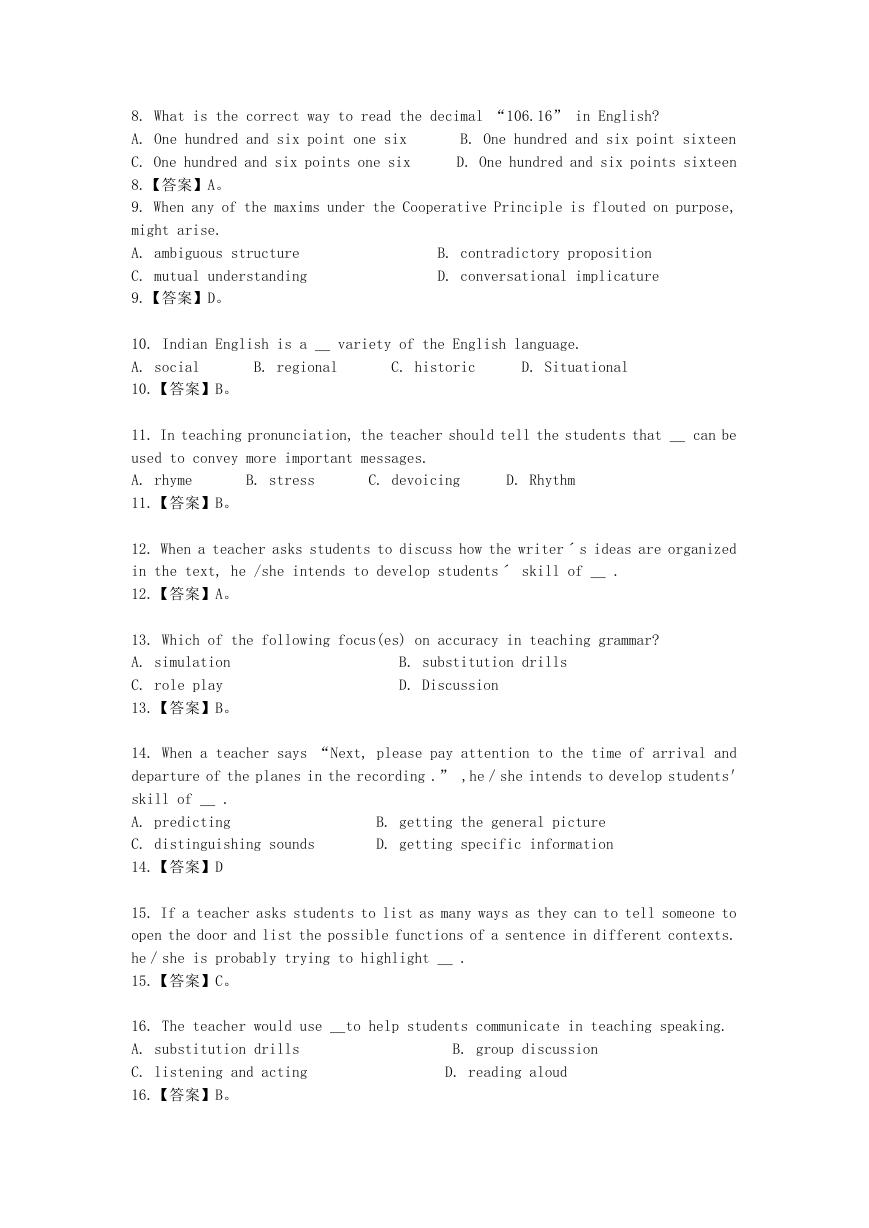

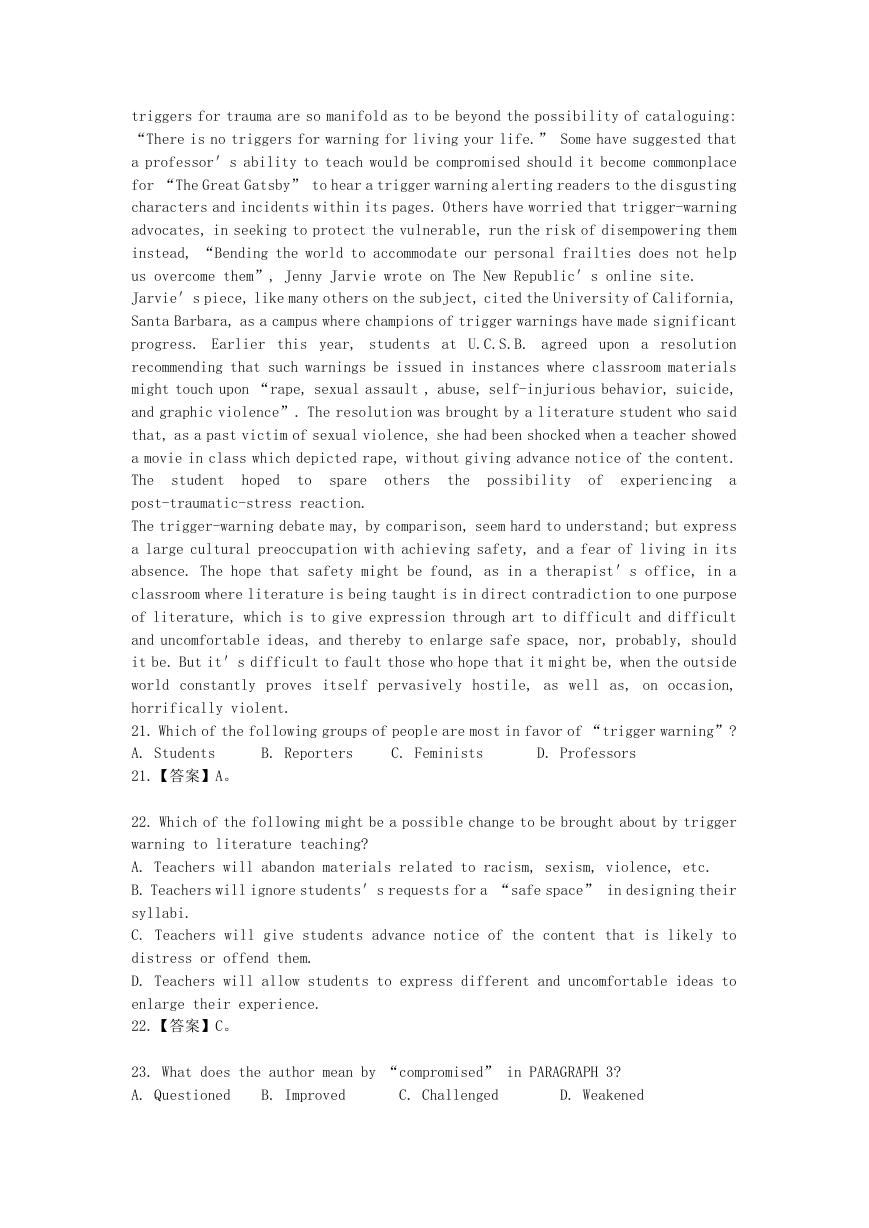

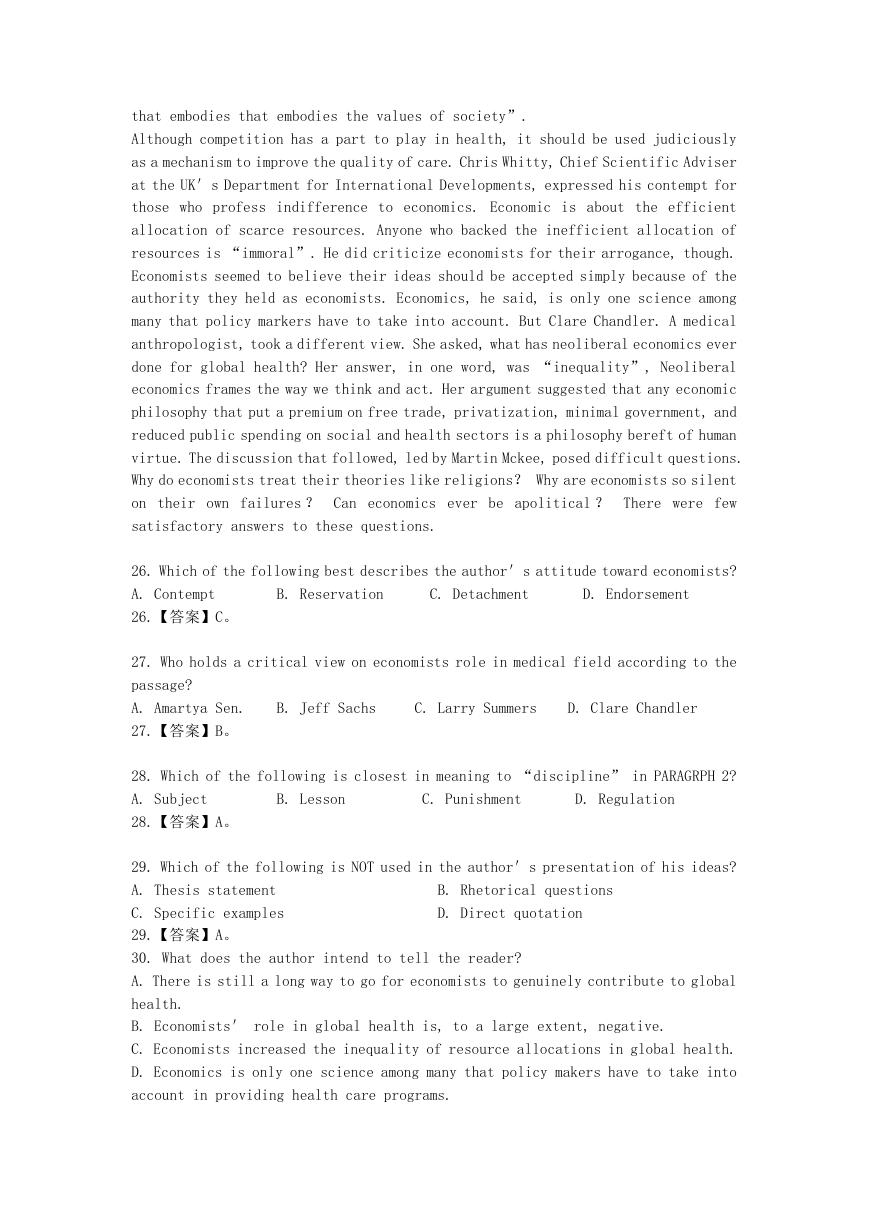
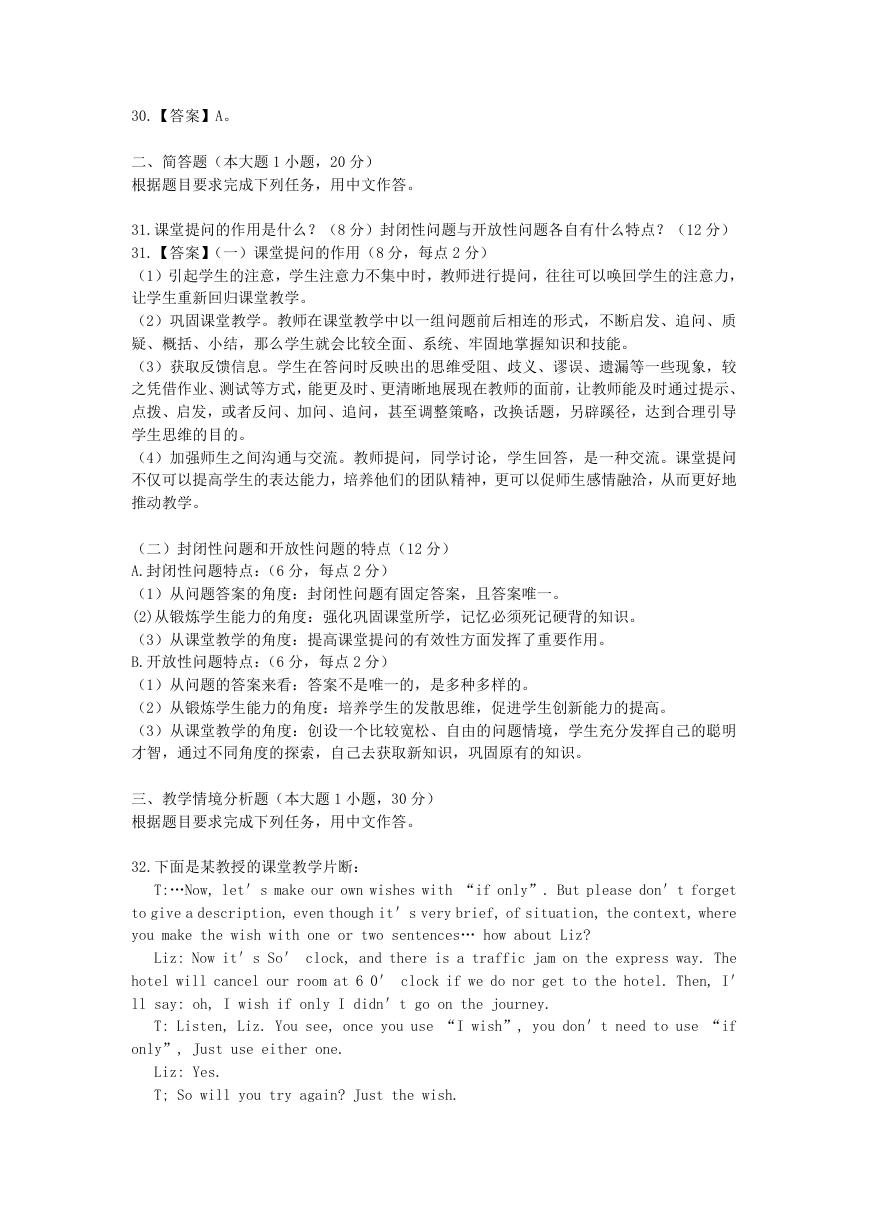
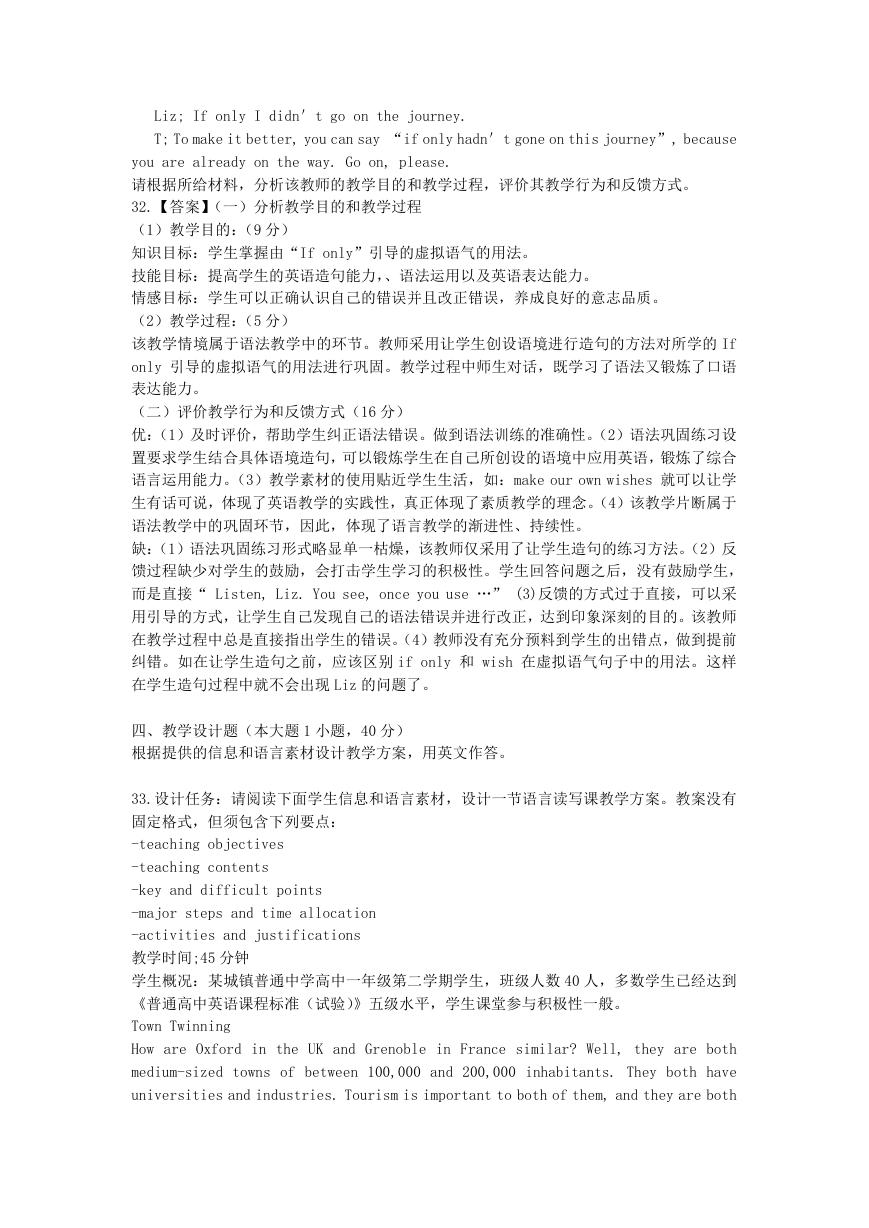








 2023年江西萍乡中考道德与法治真题及答案.doc
2023年江西萍乡中考道德与法治真题及答案.doc 2012年重庆南川中考生物真题及答案.doc
2012年重庆南川中考生物真题及答案.doc 2013年江西师范大学地理学综合及文艺理论基础考研真题.doc
2013年江西师范大学地理学综合及文艺理论基础考研真题.doc 2020年四川甘孜小升初语文真题及答案I卷.doc
2020年四川甘孜小升初语文真题及答案I卷.doc 2020年注册岩土工程师专业基础考试真题及答案.doc
2020年注册岩土工程师专业基础考试真题及答案.doc 2023-2024学年福建省厦门市九年级上学期数学月考试题及答案.doc
2023-2024学年福建省厦门市九年级上学期数学月考试题及答案.doc 2021-2022学年辽宁省沈阳市大东区九年级上学期语文期末试题及答案.doc
2021-2022学年辽宁省沈阳市大东区九年级上学期语文期末试题及答案.doc 2022-2023学年北京东城区初三第一学期物理期末试卷及答案.doc
2022-2023学年北京东城区初三第一学期物理期末试卷及答案.doc 2018上半年江西教师资格初中地理学科知识与教学能力真题及答案.doc
2018上半年江西教师资格初中地理学科知识与教学能力真题及答案.doc 2012年河北国家公务员申论考试真题及答案-省级.doc
2012年河北国家公务员申论考试真题及答案-省级.doc 2020-2021学年江苏省扬州市江都区邵樊片九年级上学期数学第一次质量检测试题及答案.doc
2020-2021学年江苏省扬州市江都区邵樊片九年级上学期数学第一次质量检测试题及答案.doc 2022下半年黑龙江教师资格证中学综合素质真题及答案.doc
2022下半年黑龙江教师资格证中学综合素质真题及答案.doc